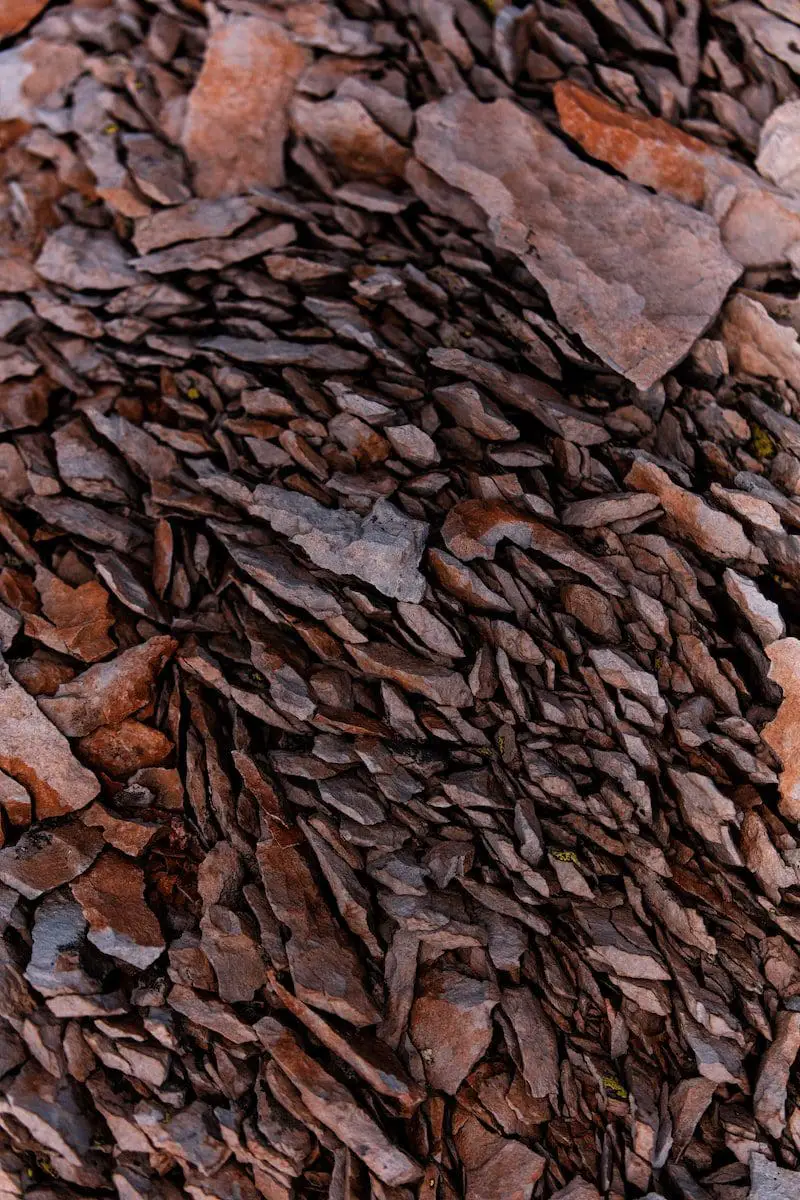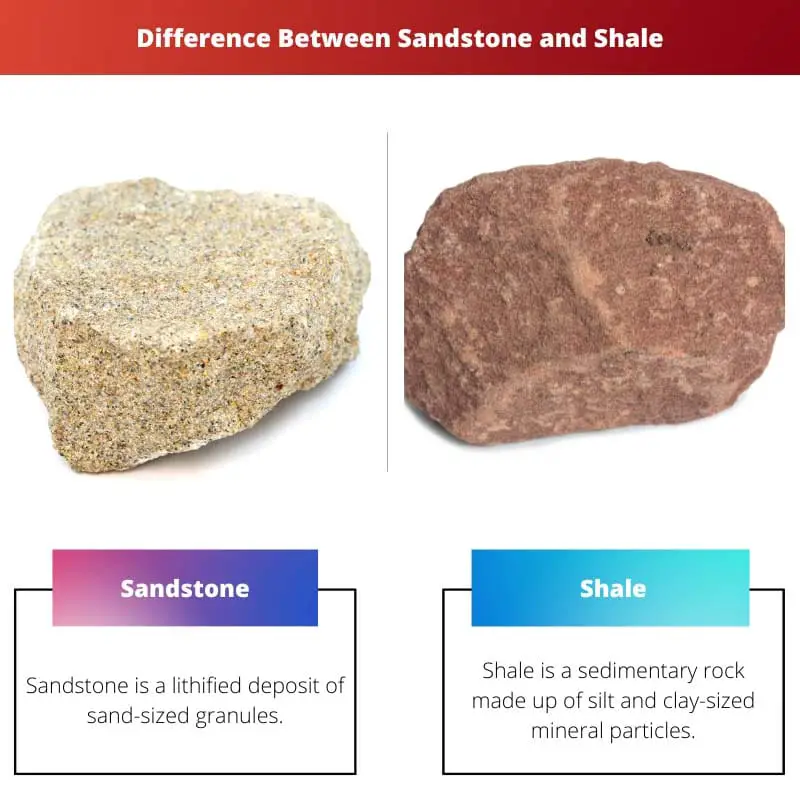Sedimentary rocks include sandstone, shale, and other types of sandstone. Sedimentary rocks are rocks that form as a result of the accumulation of sediment.
Sanstone and shale are two forms of sedimentary rocks that are found all over the world.
One of the most frequent sedimentary rocks is shale. Sandstone is a clastic sedimentary rock made up of sand-sized grains that have been cemented together to form a solid rock.
Key Takeaways
- Sandstone is a sedimentary rock formed from sand-sized mineral particles, while shale is formed from clay or silt-sized particles.
- Sandstone has a coarser texture and is more porous than shale, with a fine, laminated texture.
- Shale is more prone to breaking along its layers due to its fine-grained composition, whereas sandstone is more resistant to breakage.
Sandstone vs Shale
Sandalwood is a fragrant wood used in scent, cosmetics, and traditional medicine. It is extracted from the Santalum tree with distinct characteristics. Red sandalwood, also known as Pterocarpus santalinus, is a different tree species with a red-hued wood used for its healing and dyeing effects.

Sandstone is a lithified deposit of sand-sized granules. After shale, it is the second most prevalent sedimentary rock, accounting for 10 to 20% of all sedimentary rocks in the Earth’s crust.
Sandstones are key markers of erosional and depositional processes because of their abundance, various textures, and mineralogy.
Quartz, feldspar, and rock fragments are the main mineral elements of the framework.
Shale is a sedimentary rock made up of silt and clay-sized mineral particles that we commonly refer to as “mud.” As a result, shale is classified as a form of mudstone.
Shale is even referred to as a thin covering of mudstone. Although mud and clay make up the majority of shale, it also contains trace amounts of calcite and quartz.
Comparison Table
| Parameters of Comparison | Sandstone | Shale |
|---|---|---|
| Composition | Quartz, clay, slit, feldspar. | Mud, clay, calcite, quartz |
| Layers | Silt or clay is squeezed together to make the solid rock. | Thin layers. |
| Particles | Coarse particles | Very fine grains |
| Categories | Coarse grained rock, | Fine grained rock |
| Texture | Granular | Clastic |
| Color | Beige, light and dark grey, white, yellow, red, pink, green, colorless, brown, black, brown. | Black, green, grey, brown, red, yellow |
| Appearance | Rough | Muddy |
| Commercial Uses | Oil and gas reservoirs, tombstones, aquariums, aquifers, petroleum reservoirs. | Creating artwork, pottery |
What is Sandstone?
Quartzose sandstone is defined as sandstone that includes more than 90% quartz. Sandstone’s color changes based on its composition.
Because most rocks are made up of light-colored minerals, they are light in color. The presence of iron oxide, on the other hand, frequently results in varied colors of red.
Sandstone has a rough and grainy texture, similar to that of sandpaper. It is also one of the most frequent sedimentary rock kinds on the planet. It’s widely distributed in sedimentary basins around the world.
Sandstone classification is based on texture and mineralogical features, though there is some controversy about which properties to prioritize. Arenite and wacke are the two main types of sandstone.
Sandstone is created by cementing sand (yellow, white, or black) together and hardening it to the point that it may be called a rock.
Sandstone can be readily broken apart, scraped, and is permeable; nevertheless, sandstone is not easily corroded by rainfall (unless it is made from white sand, which is made mainly of coral).
Sandstone can be found on beaches, rivers, and lakes, as well as in deserts.
Sandstone is a rock made up of mineral or other organic material grains that are the size of sand.
It may also include a matrix of silt- or clay-size particles to fill in the gaps between the sand grains and also a cementing agent to hold the sand grains together.
If the sandstone is strong enough, it could be crushed and used in construction projects. It could be crushed and utilized as a source of silica for glass manufacture if it has a high quartz percentage.

What is Shale?
Shales contain a minimum of 30% clay minerals as well as a considerable amount of quartz. Minor amounts of carbonates, iron oxides, fossils, and organic compounds can also be discovered.
Some organic-rich shales contain enough kerogen to produce oil when heated to high temperatures.
Any of a collection of fine-grained, laminated sedimentary rocks made composed of silt- and clay-sized particles known as shale.
Shale is the most common sedimentary rock, accounting for nearly 70% of all sedimentary rocks in the Earth’s crust.
The makeup of shale determines its hue. Red, brown, or purple shale is formed when ferric iron compounds are present.
Black, blue, and green shale are produced by ferrous iron. Calcite-rich shale is pale grey or yellow in color.
Shales are economically significant, with numerous applications in the ceramics industry. They are an important supply of alumina for Portland cement and are a key raw material for tile, brick, and pottery.
Mud, sand, and silt are heaped on top of each other and compacted to form shale. Shale is not highly permeable; when saturated with water, it easily gives way, and rainwater does not erode it.
Clay with microparticles of calcite, quartz, pyrite, mica, other minerals, and organic components in compacted mud produces a fine-grained clastic sedimentary rock. Wherever there is or was previously water, shale can be found.

Main Differences Between Sandstone and Shale
- Sandstone is composed of quartz, feldspar, slit, and clay, whereas shale is composed of mud, quartz, calcite, and clay.
- In sandstone, silt is layered together tightly to make the solid rock, and in shale, there are very thin layers.
- Sandstone has coarse particles which can be seen with the naked eye alone, and shale has very fine grains which can’t be seen with the naked eye.
- Sandstone is categorized as a coarse-grained rock, and shale is categorized as a fine-grained rock.
- The texture of sandstone is granular, and shale is clastic.
- Sandstone is available in the colors of beige, brown, black, pink, red, yellow, etc. Shale is available in the colors black, yellow, grey, green, etc.
- Sandstone has a rough appearance, whereas shale has a muddy appearance.
- Sandstone can be used in oil and gas reservoirs, aquariums, etc. Shale can be used to create artwork like pottery.

References
- https://www.sciencedirect.com/science/article/pii/S1365160910001164
- https://www.sciencedirect.com/science/article/pii/S0264817201000253
